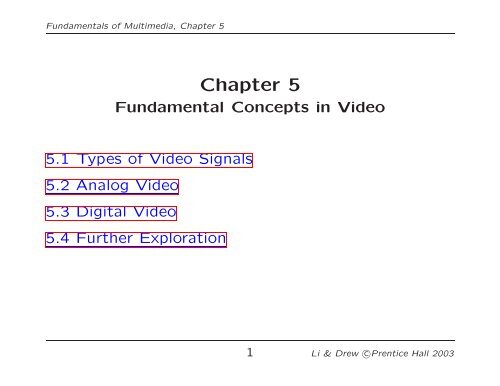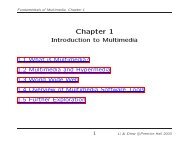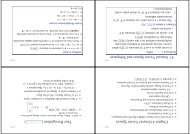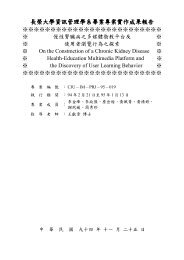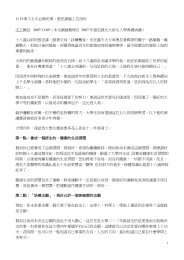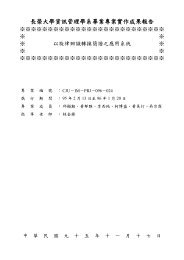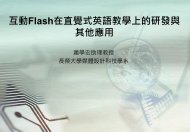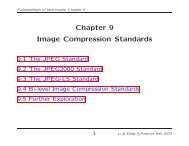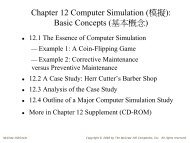Fundamental Concepts in Video
Fundamental Concepts in Video
Fundamental Concepts in Video
You also want an ePaper? Increase the reach of your titles
YUMPU automatically turns print PDFs into web optimized ePapers that Google loves.
<strong>Fundamental</strong>s of Multimedia, Chapter 5<br />
Chapter 5<br />
<strong>Fundamental</strong> <strong>Concepts</strong> <strong>in</strong> <strong>Video</strong><br />
5.1 Types of <strong>Video</strong> Signals<br />
5.2 Analog <strong>Video</strong><br />
5.3 Digital <strong>Video</strong><br />
5.4 Further Exploration<br />
1 Li & Drew c○Prentice Hall 2003
<strong>Fundamental</strong>s of Multimedia, Chapter 5<br />
5.1 Types of <strong>Video</strong> Signals<br />
Component video<br />
• Component video: Higher-end video systems make use of<br />
three separate video signals for the red, green, and blue image<br />
planes. Each color channel is sent as a separate video signal.<br />
(a) Most computer systems use Component <strong>Video</strong>, with separate<br />
signals for R, G, and B signals.<br />
(b) For any color separation scheme, Component <strong>Video</strong> gives<br />
the best color reproduction s<strong>in</strong>ce there is no “crosstalk”<br />
between the three channels.<br />
(c) This is not the case for S-<strong>Video</strong> or Composite <strong>Video</strong>, discussed<br />
next. Component video, however, requires more<br />
bandwidth and good synchronization of the three components.<br />
2 Li & Drew c○Prentice Hall 2003
<strong>Fundamental</strong>s of Multimedia, Chapter 5<br />
Composite <strong>Video</strong> — 1 Signal<br />
• Composite video: color (“chrom<strong>in</strong>ance”) and <strong>in</strong>tensity<br />
(“lum<strong>in</strong>ance”) signals are mixed <strong>in</strong>to a s<strong>in</strong>gle carrier wave.<br />
a) Chrom<strong>in</strong>ance is a composition of two color components (I and Q,<br />
orUandV).<br />
b) In NTSC TV, e.g., I and Q are comb<strong>in</strong>ed <strong>in</strong>to a chroma signal, and<br />
a color subcarrier is then employed to put the chroma signal at the<br />
high-frequency end of the signal shared with the lum<strong>in</strong>ance signal.<br />
c) The chrom<strong>in</strong>ance and lum<strong>in</strong>ance components can be separated at<br />
the receiver end and then the two color components can be further<br />
recovered.<br />
d) When connect<strong>in</strong>g to TVs or VCRs, Composite <strong>Video</strong> uses only one<br />
wire and video color signals are mixed, not sent separately. The audio<br />
and sync signals are additions to this one signal.<br />
• S<strong>in</strong>ce color and <strong>in</strong>tensity are wrapped <strong>in</strong>to the same signal,<br />
some <strong>in</strong>terference between the lum<strong>in</strong>ance and chrom<strong>in</strong>ance<br />
signals is <strong>in</strong>evitable.<br />
3 Li & Drew c○Prentice Hall 2003
<strong>Fundamental</strong>s of Multimedia, Chapter 5<br />
S-<strong>Video</strong> — 2 Signals<br />
• S-<strong>Video</strong>: as a compromise, (Separated video, or Supervideo,<br />
e.g., <strong>in</strong> S-VHS) uses two wires, one for lum<strong>in</strong>ance<br />
and another for a composite chrom<strong>in</strong>ance signal.<br />
• As a result, there is less crosstalk between the color <strong>in</strong>formation<br />
and the crucial gray-scale <strong>in</strong>formation.<br />
• The reason for plac<strong>in</strong>g lum<strong>in</strong>ance <strong>in</strong>to its own part of the<br />
signal is that black-and-white <strong>in</strong>formation is most crucial for<br />
visual perception.<br />
– In fact, humans are able to differentiate spatial resolution <strong>in</strong> grayscale<br />
images with a much higher acuity than for the color part of<br />
color images.<br />
– As a result, we can send less accurate color <strong>in</strong>formation than must<br />
be sent for <strong>in</strong>tensity <strong>in</strong>formation — we can only see fairly large blobs<br />
of color, so it makes sense to send less color detail.<br />
4 Li & Drew c○Prentice Hall 2003
<strong>Fundamental</strong>s of Multimedia, Chapter 5<br />
5.2 Analog <strong>Video</strong><br />
• An analog signal f(t) samples a time-vary<strong>in</strong>g image. Socalled<br />
“progressive” scann<strong>in</strong>g traces through a complete picture<br />
(a frame) row-wise for each time <strong>in</strong>terval.<br />
• In TV, and <strong>in</strong> some monitors and multimedia standards as<br />
well, another system, called “<strong>in</strong>terlaced” scann<strong>in</strong>g is used:<br />
a) The odd-numbered l<strong>in</strong>es are traced first, and then the even-numbered<br />
l<strong>in</strong>es are traced. This results <strong>in</strong> “odd” and “even” fields — two fields<br />
make up one frame.<br />
b) In fact, the odd l<strong>in</strong>es (start<strong>in</strong>g from 1) end up at the middle of a l<strong>in</strong>e<br />
at the end of the odd field, and the even scan starts at a half-way<br />
po<strong>in</strong>t.<br />
5 Li & Drew c○Prentice Hall 2003
<strong>Fundamental</strong>s of Multimedia, Chapter 5<br />
P<br />
R<br />
U<br />
Q<br />
S<br />
T<br />
Fig. 5.1: Interlaced raster scan<br />
V<br />
c) Figure 5.1 shows the scheme used. First the solid (odd) l<strong>in</strong>es are<br />
traced, P to Q, then R to S, etc., end<strong>in</strong>g at T; then the even field<br />
starts at U and ends at V.<br />
d) The jump from Q to R, etc. <strong>in</strong> Figure 5.1 is called the horizontal<br />
retrace, dur<strong>in</strong>g which the electronic beam <strong>in</strong> the CRT is blanked.<br />
The jump from T to U or V to P is called the vertical retrace.<br />
6 Li & Drew c○Prentice Hall 2003
<strong>Fundamental</strong>s of Multimedia, Chapter 5<br />
• Because of <strong>in</strong>terlac<strong>in</strong>g, the odd and even l<strong>in</strong>es are displaced<br />
<strong>in</strong> time from each other — generally not noticeable except<br />
when very fast action is tak<strong>in</strong>g place on screen, when blurr<strong>in</strong>g<br />
may occur.<br />
• For example, <strong>in</strong> the video <strong>in</strong> Fig. 5.2, the mov<strong>in</strong>g helicopter<br />
is blurred more than is the still background.<br />
7 Li & Drew c○Prentice Hall 2003
<strong>Fundamental</strong>s of Multimedia, Chapter 5<br />
(a)<br />
(b) (c) (d)<br />
Fig. 5.2:<br />
Interlaced scan produces two fields for each frame. (a) The<br />
video frame, (b) Field 1, (c) Field 2, (d) Difference of Fields<br />
8 Li & Drew c○Prentice Hall 2003
<strong>Fundamental</strong>s of Multimedia, Chapter 5<br />
• S<strong>in</strong>ce it is sometimes necessary to change the frame rate,<br />
resize, or even produce stills from an <strong>in</strong>terlaced source video,<br />
various schemes are used to “de-<strong>in</strong>terlace” it.<br />
a) The simplest de-<strong>in</strong>terlac<strong>in</strong>g method consists of discard<strong>in</strong>g<br />
one field and duplicat<strong>in</strong>g the scan l<strong>in</strong>es of the other field.<br />
The <strong>in</strong>formation <strong>in</strong> one field is lost completely us<strong>in</strong>g this<br />
simple technique.<br />
b) Other more complicated methods that reta<strong>in</strong> <strong>in</strong>formation<br />
from both fields are also possible.<br />
• Analog video use a small voltage offset from zero to <strong>in</strong>dicate<br />
“black”, and another value such as zero to <strong>in</strong>dicate the start<br />
of a l<strong>in</strong>e. For example, we could use a “blacker-than-black”<br />
zero signal to <strong>in</strong>dicate the beg<strong>in</strong>n<strong>in</strong>g of a l<strong>in</strong>e.<br />
9 Li & Drew c○Prentice Hall 2003
<strong>Fundamental</strong>s of Multimedia, Chapter 5<br />
White (0.714 V)<br />
Black (0.055 V)<br />
Blank (0 V)<br />
t<br />
Sync (- 0.286 V)<br />
10.9 µs<br />
Horiz. retrace<br />
52.7 µs<br />
Active l<strong>in</strong>e signal<br />
Fig. 5.3<br />
Electronic signal for one NTSC scan l<strong>in</strong>e.<br />
10 Li & Drew c○Prentice Hall 2003
<strong>Fundamental</strong>s of Multimedia, Chapter 5<br />
NTSC <strong>Video</strong><br />
• NTSC (National Television System Committee) TV standard<br />
is mostly used <strong>in</strong> North America and Japan. It uses the<br />
familiar 4:3 aspect ratio (i.e., the ratio of picture width to<br />
its height) and uses 525 scan l<strong>in</strong>es per frame at 30 frames<br />
per second (fps).<br />
a) NTSC follows the <strong>in</strong>terlaced scann<strong>in</strong>g system, and each frame is divided<br />
<strong>in</strong>to two fields, with 262.5 l<strong>in</strong>es/field.<br />
b) Thus the horizontal sweep frequency is 525×29.97 ≈ 15, 734 l<strong>in</strong>es/sec,<br />
so that each l<strong>in</strong>e is swept out <strong>in</strong> 1/15.734 × 10 3 sec ≈ 63.6µsec.<br />
c) S<strong>in</strong>ce the horizontal retrace takes 10.9 µsec, this leaves 52.7 µsec<br />
for the active l<strong>in</strong>e signal dur<strong>in</strong>g which image data is displayed (see<br />
Fig.5.3).<br />
11 Li & Drew c○Prentice Hall 2003
<strong>Fundamental</strong>s of Multimedia, Chapter 5<br />
• Fig. 5.4 shows the effect of “vertical retrace & sync” and<br />
“horizontal retrace & sync” on the NTSC video raster.<br />
Vertical retrace and sync<br />
Horizontal retrace and sync<br />
Image Data<br />
Fig. 5.4: <strong>Video</strong> raster, <strong>in</strong>clud<strong>in</strong>g retrace and sync data<br />
12 Li & Drew c○Prentice Hall 2003
<strong>Fundamental</strong>s of Multimedia, Chapter 5<br />
a) Vertical retrace takes place dur<strong>in</strong>g 20 l<strong>in</strong>es reserved for control <strong>in</strong>formation<br />
at the beg<strong>in</strong>n<strong>in</strong>g of each field. Hence, the number of active<br />
video l<strong>in</strong>es per frame is only 485.<br />
b) Similarly, almost 1/6 of the raster at the left side is blanked for<br />
horizontal retrace and sync. The non-blank<strong>in</strong>g pixels are called active<br />
pixels.<br />
c) S<strong>in</strong>ce the horizontal retrace takes 10.9 µsec, this leaves 52.7 µsec<br />
for the active l<strong>in</strong>e signal dur<strong>in</strong>g which image data is displayed (see<br />
Fig.5.3).<br />
d) It is known that pixels often fall <strong>in</strong>-between the scan l<strong>in</strong>es. Therefore,<br />
even with non-<strong>in</strong>terlaced scan, NTSC TV is only capable of show<strong>in</strong>g<br />
about 340 (visually dist<strong>in</strong>ct) l<strong>in</strong>es, i.e., about 70% of the 485 specified<br />
active l<strong>in</strong>es. With <strong>in</strong>terlaced scan, this could be as low as 50%.<br />
13 Li & Drew c○Prentice Hall 2003
<strong>Fundamental</strong>s of Multimedia, Chapter 5<br />
• NTSC video is an analog signal with no fixed horizontal resolution.<br />
Therefore one must decide how many times to sample<br />
the signal for display: each sample corresponds to one pixel<br />
output.<br />
• A “pixel clock” is used to divide each horizontal l<strong>in</strong>e of video<br />
<strong>in</strong>to samples. The higher the frequency of the pixel clock,<br />
the more samples per l<strong>in</strong>e there are.<br />
• Different video formats provide different numbers of samples<br />
per l<strong>in</strong>e, as listed <strong>in</strong> Table 5.1.<br />
Table 5.1: Samples per l<strong>in</strong>e for various video formats<br />
Format<br />
Samples per l<strong>in</strong>e<br />
VHS 240<br />
S-VHS 400-425<br />
Betamax 500<br />
Standard 8 mm 300<br />
Hi-8 mm 425<br />
14 Li & Drew c○Prentice Hall 2003
<strong>Fundamental</strong>s of Multimedia, Chapter 5<br />
Color Model and Modulation of NTSC<br />
• NTSC uses the YIQ color model, and the technique of quadrature<br />
modulation is employed to comb<strong>in</strong>e (the spectrally<br />
overlapped part of) I (<strong>in</strong>-phase) and Q (quadrature) signals<br />
<strong>in</strong>to a s<strong>in</strong>gle chroma signal C:<br />
C = I cos(F sc t) + Qs<strong>in</strong>(F sc t) (5.1)<br />
• This modulated chroma signal is also √ known as the color<br />
subcarrier, whose magnitude is I 2 + Q 2 , and phase is<br />
tan −1 (Q/I). The frequency of C is F sc ≈ 3.58 MHz.<br />
• The NTSC composite signal is a further composition of the<br />
lum<strong>in</strong>ance signal Y and the chroma signal as def<strong>in</strong>ed below:<br />
composite = Y + C = Y + I cos(F sc t)+Qs<strong>in</strong>(F sc t) (5.2)<br />
15 Li & Drew c○Prentice Hall 2003
<strong>Fundamental</strong>s of Multimedia, Chapter 5<br />
• Fig. 5.5: NTSC assigns a bandwidth of 4.2 MHz to Y ,<br />
and only 1.6 MHz to I and 0.6 MHz to Q due to humans’<br />
<strong>in</strong>sensitivity to color details (high frequency color changes).<br />
6 MHz<br />
4.2 MHz<br />
0 1.25<br />
Y I and Q<br />
4.83 5.75<br />
Picture<br />
carrier<br />
Color<br />
subcarrier<br />
Audio<br />
subcarrier<br />
6.0<br />
f (MHz)<br />
Fig. 5.5: Interleav<strong>in</strong>g Y and C signals <strong>in</strong> the NTSC spectrum.<br />
16 Li & Drew c○Prentice Hall 2003
<strong>Fundamental</strong>s of Multimedia, Chapter 5<br />
Decod<strong>in</strong>g NTSC Signals<br />
• The first step <strong>in</strong> decod<strong>in</strong>g the composite signal at the receiver<br />
side is the separation of Y and C.<br />
• After the separation of Y us<strong>in</strong>g a low-pass filter, the chroma<br />
signal C can be demodulated to extract the components I<br />
and Q separately. To extract I:<br />
1. Multiply the signal C by 2 cos(F sc t), i.e.,<br />
C · 2cos(F sc t) = I ·2cos 2 (F sc t)+Q·2s<strong>in</strong>(F sc t)cos(F sc t)<br />
= I · (1 + cos(2F sc t)) + Q · 2s<strong>in</strong>(F sc t)cos(F sc t)<br />
= I + I · cos(2F sc t)+Q·s<strong>in</strong>(2F sc t).<br />
17 Li & Drew c○Prentice Hall 2003
<strong>Fundamental</strong>s of Multimedia, Chapter 5<br />
2. Apply a low-pass filter to obta<strong>in</strong> I and discard the two<br />
higher frequency (2F sc ) terms.<br />
• Similarly, Q can be extracted by first multiply<strong>in</strong>g C by 2 s<strong>in</strong>(F sc t)<br />
and then low-pass filter<strong>in</strong>g.<br />
18 Li & Drew c○Prentice Hall 2003
<strong>Fundamental</strong>s of Multimedia, Chapter 5<br />
• The NTSC bandwidth of 6 MHz is tight. Its audio subcarrier<br />
frequency is 4.5 MHz. The Picture carrier is at 1.25 MHz,<br />
which places the center of the audio band at 1.25+4.5 =5.75<br />
MHz <strong>in</strong> the channel (Fig. 5.5). But notice that the color is<br />
placed at 1.25 + 3.58 = 4.83 MHz.<br />
• So the audio is a bit too close to the color subcarrier — a<br />
cause for potential <strong>in</strong>terference between the audio and color<br />
signals. It was largely due to this reason that the NTSC color<br />
TV actually slowed down its frame rate to 30×1, 000/1, 001 ≈<br />
29.97 fps.<br />
• As a result, the adopted NTSC color subcarrier frequency is<br />
slightly lowered to<br />
f sc =30×1,000/1, 001 × 525 × 227.5 ≈ 3.579545<br />
MHz,<br />
where 227.5 is the number of color samples per scan l<strong>in</strong>e <strong>in</strong><br />
NTSC broadcast TV.<br />
19 Li & Drew c○Prentice Hall 2003
<strong>Fundamental</strong>s of Multimedia, Chapter 5<br />
PAL <strong>Video</strong><br />
• PAL (Phase Alternat<strong>in</strong>g L<strong>in</strong>e) is a TV standard widely<br />
used <strong>in</strong> Western Europe, Ch<strong>in</strong>a, India, and many other parts<br />
of the world.<br />
• PAL uses 625 scan l<strong>in</strong>es per frame, at 25 frames/second,<br />
with a 4:3 aspect ratio and <strong>in</strong>terlaced fields.<br />
(a) PAL uses the YUV color model. It uses an 8 MHz channel and<br />
allocates a bandwidth of 5.5 MHz to Y, and 1.8 MHz each to U and<br />
V. The color subcarrier frequency is f sc ≈ 4.43 MHz.<br />
(b) In order to improve picture quality, chroma signals have alternate<br />
signs (e.g., +U and -U) <strong>in</strong> successive scan l<strong>in</strong>es, hence the name<br />
“Phase Alternat<strong>in</strong>g L<strong>in</strong>e”.<br />
(c) This facilitates the use of a (l<strong>in</strong>e rate) comb filter at the receiver<br />
— the signals <strong>in</strong> consecutive l<strong>in</strong>es are averaged so as to cancel the<br />
chroma signals (that always carry opposite signs) for separat<strong>in</strong>g Y<br />
and C and obta<strong>in</strong><strong>in</strong>g high quality Y signals.<br />
20 Li & Drew c○Prentice Hall 2003
<strong>Fundamental</strong>s of Multimedia, Chapter 5<br />
SECAM <strong>Video</strong><br />
• SECAM stands for Système Electronique Couleur Avec Mémoire,<br />
the third major broadcast TV standard.<br />
• SECAM also uses 625 scan l<strong>in</strong>es per frame, at 25 frames per<br />
second, with a 4:3 aspect ratio and <strong>in</strong>terlaced fields.<br />
• SECAM and PAL are very similar. They differ slightly <strong>in</strong> their<br />
color cod<strong>in</strong>g scheme:<br />
(a) In SECAM, U and V signals are modulated us<strong>in</strong>g separate<br />
color subcarriers at 4.25 MHz and 4.41 MHz respectively.<br />
(b) They are sent <strong>in</strong> alternate l<strong>in</strong>es, i.e., only one of the U or<br />
V signals will be sent on each scan l<strong>in</strong>e.<br />
21 Li & Drew c○Prentice Hall 2003
<strong>Fundamental</strong>s of Multimedia, Chapter 5<br />
• Table 5.2 gives a comparison of the three major analog<br />
broadcast TV systems.<br />
Table 5.2: Comparison of Analog Broadcast TV Systems<br />
Frame #of Total Bandwidth<br />
TV System Rate Scan Channel Allocation (MHz)<br />
(fps) L<strong>in</strong>es Width (MHz) Y IorU QorV<br />
NTSC 29.97 525 6.0 4.2 1.6 0.6<br />
PAL 25 625 8.0 5.5 1.8 1.8<br />
SECAM 25 625 8.0 6.0 2.0 2.0<br />
22 Li & Drew c○Prentice Hall 2003
<strong>Fundamental</strong>s of Multimedia, Chapter 5<br />
5.3 Digital <strong>Video</strong><br />
• The advantages of digital representation for video are many.<br />
For example:<br />
(a) <strong>Video</strong> can be stored on digital devices or <strong>in</strong> memory, ready<br />
to be processed (noise removal, cut and paste, etc.), and<br />
<strong>in</strong>tegrated to various multimedia applications;<br />
(b) Direct access is possible, which makes nonl<strong>in</strong>ear video<br />
edit<strong>in</strong>g achievable as a simple, rather than a complex,<br />
task;<br />
(c) Repeated record<strong>in</strong>g does not degrade image quality;<br />
(d) Ease of encryption and better tolerance to channel noise.<br />
23 Li & Drew c○Prentice Hall 2003
<strong>Fundamental</strong>s of Multimedia, Chapter 5<br />
Chroma Subsampl<strong>in</strong>g<br />
• S<strong>in</strong>ce humans see color with much less spatial resolution than<br />
they see black and white, it makes sense to “decimate” the<br />
chrom<strong>in</strong>ance signal.<br />
• Interest<strong>in</strong>g (but not necessarily <strong>in</strong>formative!)<br />
arisen to label the different schemes used.<br />
names have<br />
• To beg<strong>in</strong> with, numbers are given stat<strong>in</strong>g how many pixel<br />
values, per four orig<strong>in</strong>al pixels, are actually sent:<br />
(a) The chroma subsampl<strong>in</strong>g scheme “4:4:4” <strong>in</strong>dicates that<br />
no chroma subsampl<strong>in</strong>g is used: each pixel’s Y, Cb and<br />
Cr values are transmitted, 4 for each of Y, Cb, Cr.<br />
24 Li & Drew c○Prentice Hall 2003
<strong>Fundamental</strong>s of Multimedia, Chapter 5<br />
(b) The scheme “4:2:2” <strong>in</strong>dicates horizontal subsampl<strong>in</strong>g of<br />
the Cb, Cr signals by a factor of 2. That is, of four pixels<br />
horizontally labelled as 0 to 3, all four Ys are sent, and<br />
every two Cb’s and two Cr’s are sent, as (Cb0, Y0)(Cr0,<br />
Y1)(Cb2, Y2)(Cr2, Y3)(Cb4, Y4), and so on (or averag<strong>in</strong>g<br />
is used).<br />
(c) The scheme “4:1:1” subsamples horizontally by a factor<br />
of 4.<br />
(d) The scheme “4:2:0” subsamples <strong>in</strong> both the horizontal<br />
and vertical dimensions by a factor of 2. Theoretically, an<br />
average chroma pixel is positioned between the rows and<br />
columns as shown Fig.5.6.<br />
• Scheme 4:2:0 along with other schemes is commonly used <strong>in</strong><br />
JPEG and MPEG (see later chapters <strong>in</strong> Part 2).<br />
25 Li & Drew c○Prentice Hall 2003
<strong>Fundamental</strong>s of Multimedia, Chapter 5<br />
4:4:4 4:2:2<br />
4:1:1<br />
4:2:0<br />
Pixel with only Y value<br />
Pixel with only Cr and Cb values<br />
Pixel with Y, Cr, and Cb values<br />
Fig. 5.6: Chroma subsampl<strong>in</strong>g.<br />
26 Li & Drew c○Prentice Hall 2003
<strong>Fundamental</strong>s of Multimedia, Chapter 5<br />
CCIR Standards for Digital <strong>Video</strong><br />
• CCIR is the Consultative Committee for International Radio,<br />
and one of the most important standards it has produced is<br />
CCIR-601, for component digital video.<br />
– This standard has s<strong>in</strong>ce become standard ITU-R-601, an<br />
<strong>in</strong>ternational standard for professional video applications<br />
— adopted by certa<strong>in</strong> digital video formats <strong>in</strong>clud<strong>in</strong>g the<br />
popular DV video.<br />
• Table 5.3 shows some of the digital video specifications, all<br />
with an aspect ratio of 4:3. The CCIR 601 standard uses an<br />
<strong>in</strong>terlaced scan, so each field has only half as much vertical<br />
resolution (e.g., 240 l<strong>in</strong>es <strong>in</strong> NTSC).<br />
27 Li & Drew c○Prentice Hall 2003
<strong>Fundamental</strong>s of Multimedia, Chapter 5<br />
• CIF stands for Common Intermediate Format specified by<br />
the CCITT.<br />
(a) The idea of CIF is to specify a format for lower bitrate.<br />
(b) CIF is about the same as VHS quality. It uses a progressive<br />
(non-<strong>in</strong>terlaced) scan.<br />
(c) QCIF stands for “Quarter-CIF”. All the CIF/QCIF resolutions<br />
are evenly divisible by 8, and all except 88 are<br />
divisible by 16; this provides convenience for block-based<br />
video cod<strong>in</strong>g <strong>in</strong> H.261 and H.263, discussed later <strong>in</strong> Chapter<br />
10.<br />
28 Li & Drew c○Prentice Hall 2003
<strong>Fundamental</strong>s of Multimedia, Chapter 5<br />
(d) Note, CIF is a compromise of NTSC and PAL <strong>in</strong> that it<br />
adopts the ‘NTSC frame rate and half of the number of<br />
active l<strong>in</strong>es as <strong>in</strong> PAL.<br />
Table 5.3: Digital video specifications<br />
CCIR 601 CCIR 601 CIF QCIF<br />
525/60 625/50<br />
NTSC PAL/SECAM<br />
Lum<strong>in</strong>ance resolution 720 × 480 720 × 576 352 × 288 176 × 144<br />
Chrom<strong>in</strong>ance resolution 360 × 480 360 × 576 176 × 144 88 × 72<br />
Color Subsampl<strong>in</strong>g 4:2:2 4:2:2 4:2:0 4:2:0<br />
Aspect Ratio 4:3 4:3 4:3 4:3<br />
Fields/sec 60 50 30 30<br />
Interlaced Yes Yes No No<br />
29 Li & Drew c○Prentice Hall 2003
<strong>Fundamental</strong>s of Multimedia, Chapter 5<br />
HDTV (High Def<strong>in</strong>ition TV)<br />
• The ma<strong>in</strong> thrust of HDTV (High Def<strong>in</strong>ition TV) is not to<br />
<strong>in</strong>crease the “def<strong>in</strong>ition” <strong>in</strong> each unit area, but rather to<br />
<strong>in</strong>crease the visual field especially <strong>in</strong> its width.<br />
(a) The first generation of HDTV was based on an analog technology<br />
developed by Sony and NHK <strong>in</strong> Japan <strong>in</strong> the late 1970s.<br />
(b) MUSE (MUltiple sub-Nyquist Sampl<strong>in</strong>g Encod<strong>in</strong>g) was an improved<br />
NHK HDTV with hybrid analog/digital technologies that was put <strong>in</strong><br />
use <strong>in</strong> the 1990s. It has 1,125 scan l<strong>in</strong>es, <strong>in</strong>terlaced (60 fields per<br />
second), and 16:9 aspect ratio.<br />
(c) S<strong>in</strong>ce uncompressed HDTV will easily demand more than 20 MHz<br />
bandwidth, which will not fit <strong>in</strong> the current 6 MHz or 8 MHz channels,<br />
various compression techniques are be<strong>in</strong>g <strong>in</strong>vestigated.<br />
(d) It is also anticipated that high quality HDTV signals will be transmitted<br />
us<strong>in</strong>g more than one channel even after compression.<br />
30 Li & Drew c○Prentice Hall 2003
<strong>Fundamental</strong>s of Multimedia, Chapter 5<br />
• A brief history of HDTV evolution:<br />
(a) In 1987, the FCC decided that HDTV standards must be compatible<br />
with the exist<strong>in</strong>g NTSC standard and be conf<strong>in</strong>ed to the exist<strong>in</strong>g VHF<br />
(Very High Frequency) and UHF (Ultra High Frequency) bands.<br />
(b) In 1990, the FCC announced a very different <strong>in</strong>itiative, i.e., its preference<br />
for a full-resolution HDTV, and it was decided that HDTV<br />
would be simultaneously broadcast with the exist<strong>in</strong>g NTSC TV and<br />
eventually replace it.<br />
(c) Witness<strong>in</strong>g a boom of proposals for digital HDTV, the FCC made<br />
a key decision to go all-digital <strong>in</strong> 1993. A “grand alliance” was<br />
formed that <strong>in</strong>cluded four ma<strong>in</strong> proposals, by General Instruments,<br />
MIT, Zenith, and AT&T, and by Thomson, Philips, Sarnoff and others.<br />
(d) This eventually led to the formation of the ATSC (Advanced Television<br />
Systems Committee) — responsible for the standard for TV<br />
broadcast<strong>in</strong>g of HDTV.<br />
(e) In 1995 the U.S. FCC Advisory Committee on Advanced Television<br />
Service recommended that the ATSC Digital Television Standard be<br />
adopted.<br />
31 Li & Drew c○Prentice Hall 2003
<strong>Fundamental</strong>s of Multimedia, Chapter 5<br />
• The standard supports video scann<strong>in</strong>g formats shown <strong>in</strong> Table<br />
5.4. In the table, “I” mean <strong>in</strong>terlaced scan and “P”<br />
means progressive (non-<strong>in</strong>terlaced) scan.<br />
Table 5.4: Advanced Digital TV formats supported by ATSC<br />
# of Active # of Active Aspect Ratio Picture Rate<br />
Pixels per l<strong>in</strong>e<br />
L<strong>in</strong>es<br />
1,920 1,080 16:9 60I 30P 24P<br />
1,280 720 16:9 60P 30P 24P<br />
704 480 16:9 & 4:3 60I 60P 30P 24P<br />
640 480 4:3 60I 60P 30P 24P<br />
32 Li & Drew c○Prentice Hall 2003
<strong>Fundamental</strong>s of Multimedia, Chapter 5<br />
• For video, MPEG-2 is chosen as the compression standard.<br />
For audio, AC-3 is the standard. It supports the so-called 5.1<br />
channel Dolby surround sound, i.e., five surround channels<br />
plus a subwoofer channel.<br />
• The salient difference between conventional TV and HDTV:<br />
(a) HDTV has a much wider aspect ratio of 16:9 <strong>in</strong>stead of 4:3.<br />
(b) HDTV moves toward progressive (non-<strong>in</strong>terlaced) scan. The rationale<br />
is that <strong>in</strong>terlac<strong>in</strong>g <strong>in</strong>troduces serrated edges to mov<strong>in</strong>g objects and<br />
flickers along horizontal edges.<br />
33 Li & Drew c○Prentice Hall 2003
<strong>Fundamental</strong>s of Multimedia, Chapter 5<br />
• The FCC has planned to replace all analog broadcast services<br />
with digital TV broadcast<strong>in</strong>g by the year 2006. The services<br />
provided will <strong>in</strong>clude:<br />
– SDTV (Standard Def<strong>in</strong>ition TV): the current NTSC TV or higher.<br />
– EDTV (Enhanced Def<strong>in</strong>ition TV): 480 active l<strong>in</strong>es or higher, i.e.,<br />
the third and fourth rows <strong>in</strong> Table 5.4.<br />
– HDTV (High Def<strong>in</strong>ition TV): 720 active l<strong>in</strong>es or higher.<br />
34 Li & Drew c○Prentice Hall 2003
<strong>Fundamental</strong>s of Multimedia, Chapter 5<br />
5.4 Further Exploration<br />
−→ L<strong>in</strong>k to Further Exploration for Chapter 5.<br />
• L<strong>in</strong>ks given for this Chapter on the text website <strong>in</strong>clude:<br />
– Tutorials on NTSC television<br />
– The official ATSC home page<br />
– The latest news on the digital TV front<br />
– Introduction to HDTV<br />
– The official FCC (Federal Communications Commission)<br />
home page<br />
35 Li & Drew c○Prentice Hall 2003


